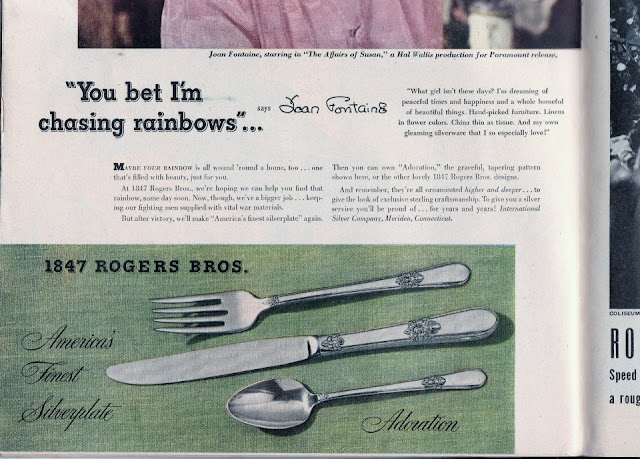The holidays are a time for tradition. Often, traditions are passed down from one generation to another: a menu, a recipe, a certain old movie or football game to watch on television. A holiday is a time to get out "special" or "best" things to set the table for a family meal.
My mother only used her "best" silverplated (sometimes just called silverplate) flatware for Thanksgiving, Christmas and Easter. The rest of the year, the 1847 Rogers Bros.* knives, forks, spoons and serving pieces lived in their special wooden felt-lined case in a cupbord. About once a year the silverplate pieces were taken out and polished, gently washed and carefully dried, then returned to their case. Cheap stainless steel flatware, which could be hand-washed (or later, put in the dishwasher), air-dried, and generally mildly abused was the choice for everyday use.
(*1847 wasn't the year they were made, by the way. That's the name of the brand.)
Silverplated flatware like this was an integral part of the lives of many families after World War II and throughout the mid-20th century.
A piece, or a set, of flatware was an excellent wedding, anniversary or Christmas gift. If you needed to replace a piece, or buy another place setting as your extended family grew larger, you could do that as well. If you were very fortunate, you would receive a set (or often just one-piece-at-a-time) of sterling silver flatware, for those special occasions. The flatware came in a variety of pretty patterns. Flatware sets were widely advertised in women's magazines in the 1940s and '50s.
"Adoration" was my parents' silverplate flatware pattern. Dad's older sisters pooled their resources and bought a set for the newlyweds, carefully packaged in a small wooden chest with cutout slots for each size and style of knife, fork, spoon and serving piece. The set included exotic items such as long-handled teaspoons, soup spoons, a ladle and butter knives, which were used even more sparingly than the rest of the flatware. My mother passed this set on to me. "Use it for special occasions," she told me. Years later, I acquired another set of silverplated flatware, still in its original case, by the same company in a different pattern when some friends were liquidating their parents' estate.
And then a few weeks ago, I spotted a handful of pieces of silverplate in a plastic bag at an estate sale. They were bright and shiny, almost like they'd never been used. The pattern was different than the other two sets I already owned.
Only a few pieces. Where was the special wooden case with the felt lining? Where were the knives, the dinner forks, the serving pieces? No one at the sale knew. There were just a few regular spoons and salad forks, a handful of soup spoons, six butter knifes, and an olive fork. Someone had cherished them once, but now they were orphans -- silverplate flatware without a special occasion. Their pattern is called "Daffodil."
I couldn't leave them there.
I will use them, as well as some pieces from my other two complete sets, for Thanksgiving and Christmas dinner this year. But it won't be the first time I've used them. I've already used them for a meal of soup, whole wheat bread and olives last month; with a chocolate peppermint loaf cake I made two weeks ago; with my tea this morning. Each time I use them, I wash and dry them carefully and put them back in the drawer with the "everyday" stainless steel flatware, where they belong.
Because every day we're alive is a special occasion. Because we live throughout the year, as the Apostle John once wrote, receiving "grace upon grace" to help us. We should celebrate.



No comments:
Post a Comment